Do you dream of capturing the breathtaking beauty of the Milky Way in photographs? It’s a celestial spectacle that has fascinated stargazers for centuries.
However, the challenge lies in the “how.” Taking stunning Milky Way pictures requires equipment, location, and technique.
But fret not, as I’ve got the solution. In this article, I’ll guide you through the intricacies of astrophotography, providing the knowledge and tools you need to capture the Milky Way’s intricate beauty. From camera settings to finding the perfect location, I’ll equip you with the essentials to turn your dream into a captivating reality.
How are Milky Way pictures taken?
To capture the beauty of the Milky Way, you’ll need the right equipment, including a camera with manual controls, a wide-angle lens, and a sturdy tripod. Understanding camera settings, finding dark sky locations, and mastering post-processing are key to success.
Let’s dive right in.
Recommended For You
How Are Milky Way Pictures Taken? Equipment Overview
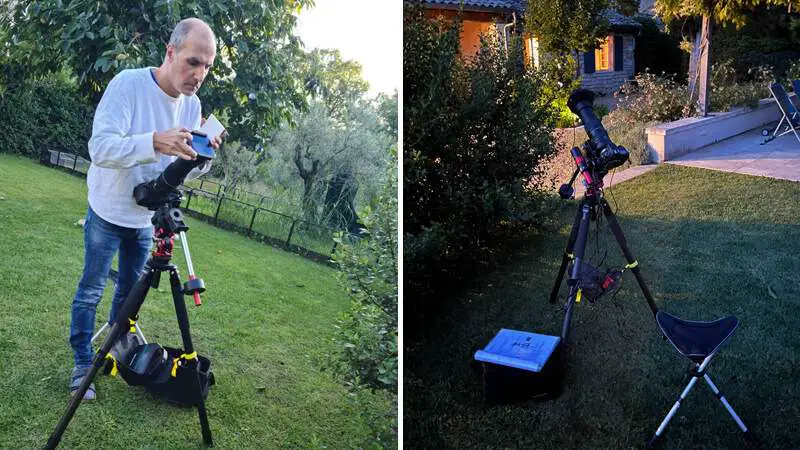
To capture stunning Milky Way photos, you’ll need some specialized equipment. Here are the essentials:
Camera
First and foremost, you’ll need a camera that allows you to control the exposure settings manually. Look for a camera with a high ISO range and low noise performance, as you’ll likely be shooting in low-light conditions. A DSLR camera or mirrorless camera is ideal, but even some high-end smartphones can work in a pinch.
Camera Lens
A wide-angle lens is essential for capturing the vast expanse of the Milky Way. Popular lenses for Milky Way photography include the Rokinon 14mm f/2.8 and the Sigma 24mm f/1.4. Look for a lens with a fast maximum aperture (f/2.8 or wider) to let in as much light as possible.
Tripod
A sturdy tripod is crucial for keeping your camera steady during long exposures. Look for a tripod that can support the weight of your camera and lens and has adjustable legs to accommodate uneven terrain. A ball or pan-tilt head will allow you to make precise adjustments to your composition.
Star Tracker
You’ll want to use a star tracker to capture a genuinely stunning Milky Way photo. This device attaches to your tripod and moves your camera in sync with the stars, allowing you to take longer exposures without star trails. Popular star trackers include the Sky-Watcher Star Adventurer and the iOptron SkyGuider Pro.
I personally use the iOptron SkyGuider Pro and am very pleased with its results. In the above photo I’m setting up for a night of astrophotography.
To summarize, you’ll need a camera with manual controls, a wide-angle lens with a fast aperture, a sturdy tripod, and a star tracker for longer exposures to take stunning Milky Way photos.
FREE STARGAZING CHECKLIST
My 5-page Stargazing Checklist will enhance your astronomical observations.
Follow this free checklist to navigate the night sky with confidence, clarity, and a sense of preparedness for a rewarding stargazing experience.

Telescopes Used for Milky Way Photography
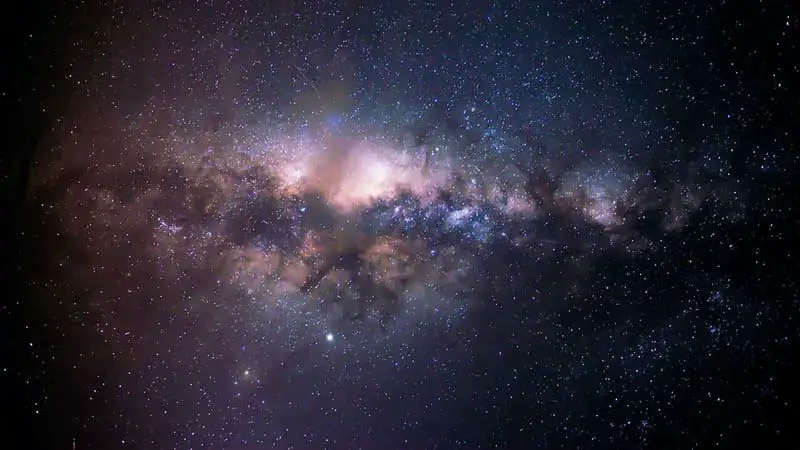
How can you utilize telescopes for Milky Way photography?
Telescopes for Milky Way photography are powerful tools designed to capture intricate details of distant celestial objects, enabling breathtaking shots of our galaxy’s beauty, all while providing enhanced light-gathering capabilities for stunning night sky imagery.
When taking stunning pictures of the Milky Way, the type of telescope you use can make all the difference. Astrophotographers use three main types of telescopes for Milky Way photography: refractor, reflecting, and catadioptric telescopes.
Refractor telescopes are the most common type of telescope used for astrophotography. They use lenses to focus light, which is excellent for capturing sharp, clear images of the Milky Way. Refractor telescopes are easy to use and maintain and relatively affordable compared to other telescopes. However, they have a smaller aperture than other types of telescopes, which means they may capture less light than you’d like.
Reflecting telescopes use mirrors to focus light, which is great for capturing bright, detailed images of the Milky Way. They have a larger aperture than refractor telescopes, which means they can capture more light and produce brighter images. Reflecting telescopes are also relatively affordable and easy to use, making them popular among astrophotographers.
Catadioptric telescopes are a combination of refractors and reflecting telescopes. They use both lenses and mirrors to focus light, which gives them a larger aperture than refractor telescopes and a longer focal length than reflecting telescopes. Catadioptric telescopes are great for capturing detailed images of the Milky Way, but they can be more expensive and complex than other types of telescopes.
When choosing a telescope for Milky Way photography, you must consider your budget, experience level, and photography goals.
- Refractor telescopes are a good choice for beginners or photographers on a budget.
- Reflecting telescopes are a good choice for photographers who want bright, detailed images of the Milky Way.
- Catadioptric telescopes suit experienced astrophotographers who want the best of both worlds. Here are some tips to help you choose the right telescope:
Camera Settings for Milky Way Photography
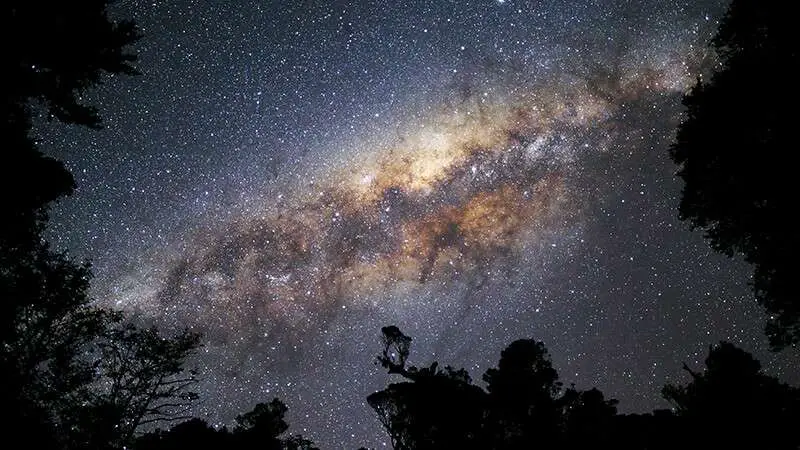
What are the optimal camera settings for capturing the Milky Way?
To capture the Milky Way’s splendor, set your camera to a wide aperture (f/2.8 or lower), a high ISO (1600-3200), and a long exposure (20-30 seconds). Use a sturdy tripod and a wide-angle lens to compose your shot, ensuring minimal light pollution for stellar results.
When capturing stunning Milky Way photos, the camera settings are crucial. These night sky photography settings may be different than what you’re used to with landscape photography. In this section, I will walk you through the three most important settings: ISO, aperture, and shutter speed.
ISO Settings
The ISO setting controls the camera’s sensitivity to light. You should set your camera to manual mode for Milky Way photography and choose a high ISO setting. ISO 3200 or 6400 is a good starting point, but you can experiment with higher settings like ISO 12800 if needed. Remember that higher ISO settings can introduce more noise in your photos.
Aperture Settings
The aperture setting controls the amount of light that enters the camera. For Milky Way photography, you want to use the widest aperture possible. A lens with an aperture of f/2.8 or wider is ideal. If your lens has no wide aperture, try using an aperture of f/4 or f/5.6.
Shutter Speed Settings
The shutter speed setting controls how long the camera’s sensor is exposed to light. You want to use a long shutter speed for Milky Way photography to capture as much light as possible. A shutter speed of 15 seconds, 20 seconds, or 30 seconds is a good starting point. Remember that longer shutter speeds can introduce motion blur if you’re not using a tripod.
To get the best results, I recommend shooting in RAW format and setting your white balance to “daylight” or “auto.” Additionally, you can use a remote shutter release or the camera’s self-timer to avoid camera shake.
Here are some tips to keep in mind when adjusting your camera settings for Milky Way photography:
- Use manual mode to have complete control over your camera’s settings.
- Choose a high ISO setting to capture more light, but be aware of noise in your images.
- Use a wide aperture to let in as much light as possible.
- Use a long shutter speed to capture more light, but be aware of motion blur.
- Shoot in RAW format and set your white balance to “daylight” or “auto.”
- Use a tripod or other stabilization method to avoid camera shake.
In the next section, I will discuss the importance of finding a dark location for Milky Way photography and how to focus your camera at night.
Location and Timing for Milky Way Photography
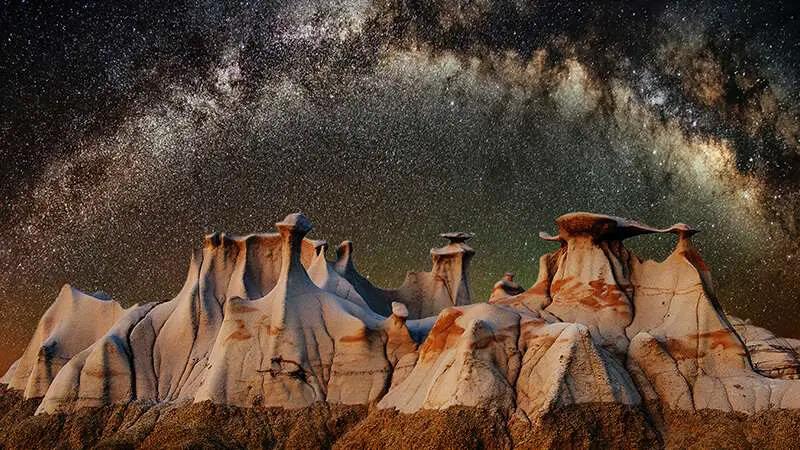
Where and when should you plan your Milky Way photography sessions?
To capture the Milky Way in all its glory, choose a remote location away from light pollution, ideally during the new moon phase when the night sky is darkest. Timing is crucial; aim for the hours around midnight when the Milky Way arches prominently across the sky, offering the best opportunities for stunning astrophotography.
Capturing stunning Milky Way images requires careful planning and preparation. Here are some essential tips on choosing the right location and time for your Milky Way photography.
Light Pollution
Light pollution is one of the biggest challenges for Milky Way photography. It washes out the stars and makes capturing the Milky Way’s details difficult. Choose a dark sky location far from city lights to avoid light pollution. You can use light pollution maps to find the nearest dark sky location. Additionally, you can use light pollution filters to reduce the impact of light pollution on your images.
Click through to these articles to find excellent dark sky locations for capturing Milky Way photos:
- Arizona, especially Sedona
- California, especially Joshua Tree and Death Valley
- Colorado
- Florida
- Hawaii: Kauai, Maui, and Oahu
- Texas: Big Bend National Park
- Utah, especially Moab
Moon Phase and Position
The moon can also affect your Milky Way photography. It would be best to avoid shooting during a full moon as it can wash out the stars. Instead, try to shoot during a new moon when the sky is darkest. Additionally, it would help if you positioned the moon outside of the frame to avoid any moonlight interference. For the best Milky Way image, include the Milky Way core.
Weather Conditions
Clear skies are essential for Milky Way photography. Clouds can ruin your shot, so checking the weather forecast before heading out is vital. If the forecast is cloudy, it’s best to reschedule your shoot.
To summarize, when choosing a location and time for your Milky Way photography, you should:
- Choose a dark sky location far away from city lights.
- Use light pollution maps and filters to avoid light pollution.
- Shoot during the Milky Way season.
- Avoid shooting during a full moon and position the moon outside of the frame.
- Check the weather forecast and avoid shooting on cloudy nights.
Post-Processing Milky Way Images
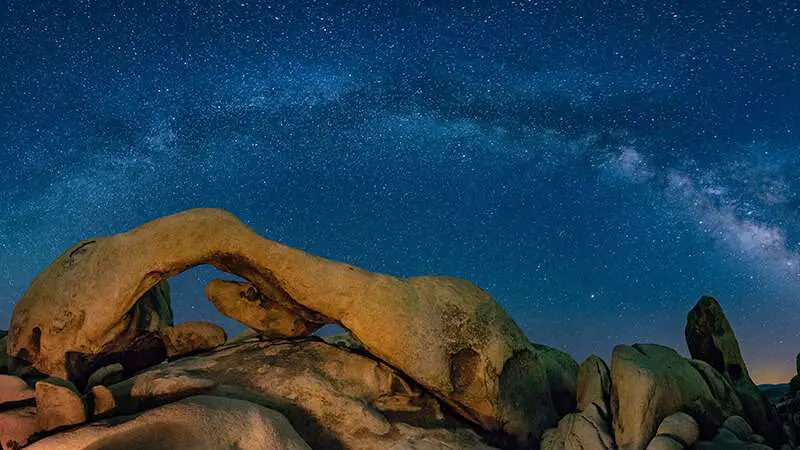
How can you enhance your Milky Way images during post-processing?
During post-processing, bring out the brilliance of your Milky Way shots by adjusting contrast, reducing noise, and enhancing the Milky Way’s intricate details. Use software like Adobe Lightroom or Photoshop to fine-tune colors, brightness, and sharpness. You can transform your initial captures into stunning celestial masterpieces with careful editing.
Post-processing is a crucial step in creating stunning images that stand out. After capturing your Milky Way images, it’s time to process the raw images to bring out their full potential. This section will cover the three essential post-processing techniques: noise reduction, color correction, and image stacking.
Noise Reduction
Milky Way photography often involves high ISO settings, which can introduce noise into your images. Fortunately, there are several noise reduction software options available that can help. Some popular options include Adobe Photoshop, Topaz DeNoise, and Nik Dfine.
When using noise reduction software, it’s essential to balance reducing noise and maintaining image detail. More noise reduction can result in a loss of detail and sharpness, while too little can leave your images looking noisy and grainy.
Color Correction
Color correction is an essential step in post-processing Milky Way images. The colors in your images can be affected by light pollution, camera settings, and other factors. Color correction software can help you adjust the colors in your photos to create a more natural and pleasing look.
Some popular color correction software options include Adobe Lightroom, Capture One, and DxO PhotoLab. When using color correction software, it’s essential to adjust the colors gradually and avoid making drastic changes that can result in an unnatural-looking image.
Image Stacking
Image stacking is a technique used to combine multiple images to create a final image with reduced noise and increased detail. This technique is advantageous in Milky Way photography, where capturing a single image with optimal exposure and low noise can be challenging.
Image stacking software options include Starry Landscape Stacker, Sequator, and DeepSkyStacker. When stacking images, it’s essential to ensure that they are aligned correctly and that the software is set up correctly to avoid creating artifacts or other issues.
In summary, post-processing is crucial in creating stunning Milky Way images. By using noise reduction, color correction, and image stacking techniques, you can create images that stand out and capture the beauty of the night sky.
Frequently Asked Questions
How do I take Milky Way photos with my phone?
Taking photos of the Milky Way with your phone can be a fun and rewarding experience. First, find a location with low light pollution and a clear night sky view. Use a tripod to keep your phone steady and reduce blur. Adjust your camera settings to a high ISO and a long exposure time to capture as much light as possible. Use a remote shutter or a self-timer to prevent camera shake. Experiment with different angles and compositions to create unique and exciting photos.
Is there a Milky Way position calculator?
Yes, several Milky Way position calculators are available online to help you plan your astrophotography sessions. These calculators use your location and the date and time to predict the position of the Milky Way in the sky. Some popular calculators include PhotoPills, Stellarium, and The Photographer’s Ephemeris. Using a Milky Way position calculator, you can plan your shoot and ensure that you are in the right place at the right time to capture stunning photos of the Milky Way.
Milky Way Pictures Summary
Thank you for reading my article “How Are Milky Way Pictures Taken?”
Taking pictures of the Milky Way can be a challenging but rewarding experience. Capturing the beauty of our entire Milky Way galaxy, including its galactic center, requires the right equipment, location, and technique.
- You need to find a location with minimal light pollution. Get away from cities and towns to a place with a clear night sky view. You can use Dark Site Finder or Light Pollution Map apps to find dark and clear sky locations near you.
- It would be best if you had the right equipment. A camera with manual controls and a wide-angle lens with a low aperture (f/2.8 or lower) is essential for star photography. A tripod is also necessary to keep your camera steady during long exposure shots.
- You need to know the proper settings for your camera. You should set your camera to manual mode and adjust the shutter speed, aperture, and ISO to capture the Milky Way. A good starting point is a shutter speed of 20-30 seconds, an aperture of f/2.8, and an ISO of 3200.
- It would help if you focused your camera on the stars. You can do this by using manual focus or focusing on a bright star using autofocus and then switching to manual focus. You can also use a “live view” technique to zoom in on a star and manually focus on it.
- Milky Way photography requires trial and error; you may need multiple shots for perfect image quality. You need to be patient and persistent. Keep going even if your first attempts do not capture this fabulous celestial object successfully.
In summary, taking pictures of the Milky Way requires finding a dark sky location, having the right equipment, knowing the correct settings, focusing on the stars, and being patient. With these tips, you can capture the beauty of our galaxy and create stunning Milky Way pictures that you can be proud of.
Read my other articles in my Milky Way series:
- Can You See the Milky Way with a Half Moon?
- How Many Solar Systems in the Milky Way?
- When is Milky Way Season?
- Why Does the Milky Way Look Cloudy?
- Are all the stars we see in the Milky Way?
- Does the Milky Way orbit anything?
- Are the constellations in the Milky Way?
- Can you see the Milky Way with a full moon?
- Can you see the Milky Way on a cruise?
- Can I See the Milky Way with My Eyes?




